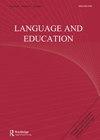生存还是繁荣?综合EMI跨国高等教育背景下学生自我调节听力练习的叙事轨迹
IF 2.8
2区 文学
Q1 EDUCATION & EDUCATIONAL RESEARCH
引用次数: 1
摘要
英语媒介教学(EMI)伴随着二十年来对第二语言自主学习的研究而迅速发展。在这两个领域,听力的研究仍然不足,纵向设计的应用不足,深入研究是必要的,以揭示学习者的发展。在一个被认为是自主学习的背景下,本研究采用纵向定性设计来探索34名中国学生从中文高中到中国EMI跨国大学第一学期的课外自主听力练习。在Zimmerman自我调节学习的社会认知模型的指导下,采用主题分析和叙事分析的方法对102份学生过渡学期开始、中期和结束时的访谈记录进行分析。研究结果按时间顺序呈现,作为学生叙事轨迹的综合。他们强调了学生们最初对自我调节听力练习的热情,以“挺过”EMI课程,以及期中考试的分水岭时刻,当时许多“辍学生”认为自己的熟练程度已经达到了一个抽象的门槛,于是停止了练习。“继承者”在元认知意识和情绪调节策略的指导下,通过追求长期的、面向未来的目标,发展了可持续的实践,这些目标超出了当前的EMI环境。提供了支持未来学生群体在过渡期间和以后茁壮成长的教学意义。本文章由计算机程序翻译,如有差异,请以英文原文为准。
To survive or to thrive? Synthesizing the narrative trajectories of students’ self-regulated listening practice in an EMI transnational higher education context
English-medium instruction (EMI) has burgeoned alongside two decades of L2 self-regulated learning research. In both areas, listening remains under-researched, longitudinal designs are under-employed, and in-depth studies are necessary to unpack learner development. In a context believed to initiate self-regulated learning, the current study employed a longitudinal qualitative design to explore the out-of-class, self-regulated listening practice of 34 Chinese students across their first term transitioning from Chinese-medium high schools to an EMI transnational university in China. Guided by Zimmerman’s social-cognitive model of self-regulated learning, 102 transcripts generated from interviewing students at the beginning, middle, and end of their transition term were analyzed using thematic analysis and narrative analysis. The findings are presented chronologically as a synthesis of the students’ narrative trajectories. They highlight the students’ initial enthusiasm for self-regulated listening practice to ‘survive’ EMI lectures and a watershed moment at the midterm, when many ‘dropouts’ stopped practicing as they perceived their proficiency had reached an abstract threshold. The ‘continuers’ developed sustainable practices informed by the pursuit of long-term, future-oriented goals that outreached the immediate EMI context, guided by metacognitive awareness and emotion regulation strategies. Pedagogical implications to support future cohorts of students to thrive during transition and beyond are provided.
求助全文
通过发布文献求助,成功后即可免费获取论文全文。
去求助
来源期刊

Language and Education
Multiple-
CiteScore
4.70
自引率
0.00%
发文量
34
期刊介绍:
Language & Education provides a forum for the discussion of recent topics and issues in the language disciplines which have an immediate bearing upon thought and practice in education. Articles draw from their subject matter important and well-communicated implications for one or more of the following: curriculum, pedagogy or evaluation in education. The task of the Journal is to encourage language specialists and language in education researchers to organise and present their material in such a way as to highlight its educational implications, thereby influencing educational theorists and practitioners and therefore educational outcomes for individual children.
 求助内容:
求助内容: 应助结果提醒方式:
应助结果提醒方式:


